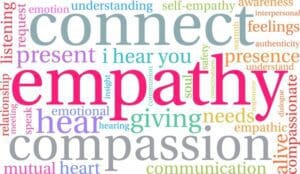 Stop Complaining Your Leaders Don’t Display Empathy
Stop Complaining Your Leaders Don’t Display Empathy
That’s not how it works; understanding empathy comes first, then acting on the emotion.
It’s time to get all touchy-feely…Yes. Touchy-Feely. Empathy is not some structured behavior that you can comply with. I need more “Are you OK’s” with your returning employees isn’t empathy. That kind of expectation will cause more challenges than it will solve. If you want a better culture, a culture that has value, a culture that returning employees will value (and, by the way, business used to actually have), empathy must be learned and embraced.
But what the heck does empathy really mean?
The action of understanding, being aware of, being sensitive to, and vicariously experiencing the feelings, thoughts, and experiences of another in either the past or present without having the feelings, thoughts, and experiences fully communicated in an objectively explicit manner also: the capacity for this.
Meriam Webster
Please note: It says nothing about acting on or doing something. This is about your awareness and how it makes you feel…
So, when we talk about empathy or empathetic leadership, it begins with the “self.” Yep, you must feel something. Leading from a place that starts with (ugh) feeling something has become so foreign to most modern leaders that when I begin the training, I am compelled to warn people that this is going to potentially open up something that is totally new and will change the way they perceive outstanding leadership. I’ve had people break down and cry at the sudden awareness of empathy in themselves (and yes, I’ve had people laugh and walk out.)
It’s a lot!
When you suddenly add feeling to your leadership and acknowledge it’s important, it changes you. Combine this with communication that is tied to authenticity, and suddenly management becomes leadership, and people start to grow and excel.
Quick Exercise: Picture this:
You are at a large petting zoo. You are there with a friend or family, and you hear crying. You turn slowly and see a 4ish-year-old little boy standing, arms at her side, alone, looking into the eyes of “in his mind” a killer sheep. He is looking desperately around, crying his eyes out, frozen in place with fear.

- Make two columns on a piece of paper label the columns, Me and Him.
- Write down as many words as possible to describe your feelings and then pause: Look at the list.
- Take a breath, and then…
- Repeat with as many words as you can to describe what you think he feels:
Looking at the list, are they the same? Different? Drastically opposed?
Most importantly, can you emotionally (back to touchy-feely) place yourself in her shoes? Maybe you can even remember feeling lost like that as a child. Empathy is just like that with “grown-ups.” They get lost and sometimes have no idea what to do… and much more. Can you feel what they feel?
Empathy is possessing that capacity. To stand in someone else’s shoes and potentially feel what they feel. What you do and the proper application of that empathy is the next step, but we have to know that feeling, good, bad, or indifferent, before we act. That’s where empathetic leadership must start with acknowledging and embracing the simple truth that the internal feeling of empathy, caring, consideration, and the emotions associated with having empathy will then guide your behavior.
Robert Pappas
Founder
562.547.9048
#robertism, #coaching #training #empathy #leadership #operations #communications #LinQuage #mentor

